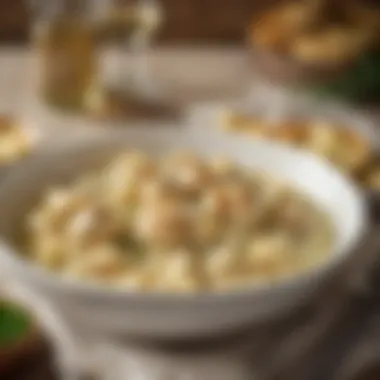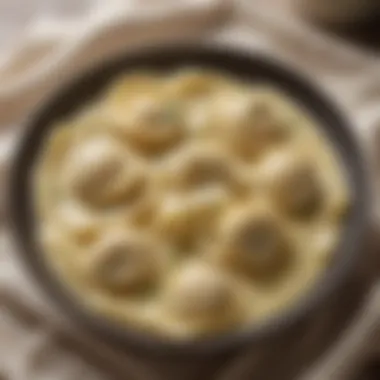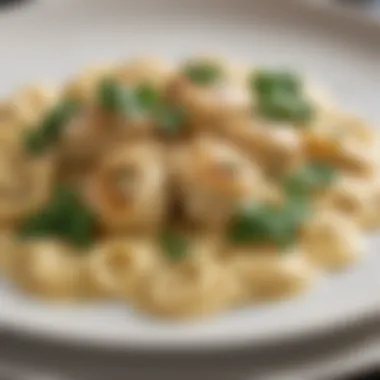Exploring Chicken Tortellini Alfredo: A Culinary Journey


Intro
Chicken Tortellini Alfredo invites you into a realm of flavors and textures that merge tender pasta, succulent chicken, and a creamy savory sauce. This dish promises unmatched satisfaction and should be mastered for any culinary enthusiast. Here, we embark on a meticulous exploration of its nuances, ensuring that even novice and discerning cooks can appreciate its charm. Every ingredient matters, and each cooking technique elevates the final dish. Thus, understanding these nuances not only enhances your skill set but also allows a deeper appreciation of classic cooking.
Ingredients Breakdown
Primary Ingredients
- Tortellini – Chewy and slightly extra-flavored dough filled with various ingredients, often cheese or meats.
- Chicken – Typically boneless, skinless chicken breasts are recommended for their ease of cooking and ability to absorb flavor.
- Heavy Cream – This forms the basis of the Alfredo sauce, lending the intended richness and velvety texture.
- Parmesan Cheese – Aged and grated cheese that provides a distinct flavor and the right degree of saltiness.
- Garlic – Fresh garlic adds aromatic qualities that complement the creamy sauce.
Optional Ingredients
- Broccoli – A nutrient-filled addition that also imparts color to the dish.
- Spinach – Offers taste and can enhance the nutritional profile.
- Herbs – Parsley or basil can enhance freshness and elevate presentation.
- Chicken broth – Adds a depth of flavor to the sauce without the extra calories.
Essential Kitchen Tools
- Pasta Pot – Large enough to accommodate the tortellini for even cooking.
- Saute Pan – For the seamless blending of sauce and protein.
- Whisk – Ensures a smooth texture while combining ingredients.
- Wooden Spoon – Handy for stirring.
- Grater – For the Parmesan cheese.
Step-by-Step Preparation
Prepping the Ingredients
Start by boiling water in a large pot. It's imperative to salt your water, as this adds flavor directly to the tortellini during cooking. Chop garlic finely, and if using vegetables like broccoli or spinach, wash and prepare them for cooking.
Cooking Techniques and Methods
- Cooking the Tortellini: Add tortellini to boiling water. Follow package instructions for cooking times, but taste often for preferred tenderness.
- Sautéing Chicken: In the sauté pan, heat a tablespoon of oil. Add chicken pieces and cook until golden brown on all sides. This step ensures a flavorful protein addition.
- Making Alfredo Sauce: After removing chicken, decrease heat and add garlic to the pan. Sweating the garlic induces heavy cream next, whisking briskly, then integrating Parmesan cheese allows a creamy consistency.
Assembly and Presentation Tips
Combining each component will take you closer to an artful dish. First, return the cooked chicken to the pan, giving it a sesame of time to absorb sauce flavor. Then, add the drained tortellini; ensure even coating of sauce. Finish with herbs for garnish, sightly drizzling a bit of oil can improve overall shining and allure.
Dietary Considerations
Gluten-Free Options
For a gluten-free variant, seek out certified gluten-free tortellini or create fresh sheets from rice flour. Both approaches allows gluten standards to remain respected while enjoying the dish.
Vegetarian and Vegan Substitutes
A variety of alternatives exists. Use plant-based chicken options or simply increase the vegetable content. Nutritional yeast can act as nutritional delicacy in the place of Parmesan cheese or almond cream works as a luscious sauce stage.
Nutrition Facts & Nutritional Considerations
Understanding the nutritional aspects can help you adjust according to dietary themes. Chicken adds protein, while tortellini and cream introduce carbohydrates and fats. Moderation remains the key essence.
Variations and Customizations
Flavor Enhancements
For different dimensions consider adding spices like black pepper, cayenne, or even lemon zest which creates an invigorating familiar tone within Alfredo.
Alternative Cooking Methods
One could also bake the assembled dish in the oven with cheese on top for a crunchy crust before serving.
Pairing Suggestions (Sides, Drinks, etc.
)
White wines, Oaked Chardonnay is a smooth connoisseur choice, while side salads can align fresh raw vegetables maximizing overall nourishment. Moreover, garlic bread compliments well, fostering crunchy texture apart from pasta.
Common Common Questionss and Troubleshooting
Frequently Asked Questions
Does my private touch make a difference?
Yes, unique preferences contribute willingly. Adjusting ingredients assists in personalizing tastes!


Common Mistakes to Avoid
Be mindful of skimping on cheese or waiting too long to integrate chicken back; both lead variations, often unsatisfactory.
Solutions to Potential Problems
Insufficient cream?:: Enjoying water from cooked tortellini addition resolves adding desired texture fixing worry around thickness.
Understanding every component is central in creating full flavors. Embracing alternate fails can heighten skills while juggling through each step.
In closing, Chicken Tortellini Alfredo acts as not just a dish but a journey through flavors and culinary traditions accrued from the ages. Merging these ingredients and techniques, one creates more than a meal; the essence of culinary art emerges.
Intro to Chicken Tortellini Alfredo
Chicken Tortellini Alfredo stands out as a notable dish in the realm of Italian cuisine. It serves as an ideal marriage of flavors and textures, attracting both novices and experienced cooks alike. This introduction underscores the significance of Chicken Tortellini Alfredo by exploring its composition and appeal.
Defining Chicken Tortellini Alfredo
To understand Chicken Tortellini Alfredo, one must first grasp the individual components of the dish. Tortellini, a small, ring-shaped pasta, often enshrines fillings made from cheese, meat, or vegetables. Chicken, typically sautéed or grilled, adds protein and richness. The radiance of the dish lies in the Alfredo sauce, a creamy concoction made from butter, heavy cream, and parmesan cheese. When blended together, these elements create a delightful plate that is both comforting and sophisticated. Notably, this dish is presented in various styles across different regions.
Thus, Chicken Tortellini Alfredo serves as more than just a meal. It resonates with traditions, culture, and an appreciation for the art of cooking.
The Appeal of Alfredo Sauce
The allure of Alfredo sauce plays a critical role in the overall success of Chicken Tortellini Alfredo. This sauce encompasses the essence of creamy comfort food that many crave. Unlike other pasta sauces that might rely heavily on tomatoes or vinaigrettes, Alfredo sauce stands out as a velvety option.
Its simple ingredients, including butter, heavy cream, and parmesan, blend seamlessly together. This brings a luxurious texture that clings to the pasta beautifully, enhancing the experience of each bite. Adding flavor is quite easy: the incorporation of garlic, black pepper, and sometimes nutmeg can elevate the richness without overpowering.
Moreover, Alfredo sauce caters to varying palates. It can communicate simplicity for those seeking a subtle experience, or boldness for those who enjoy layered flavors. This versatility ensures that Chicken Tortellini Alfredo remains relevant in various culinary scenarios.
Knowing both the composition of tortellini and the multifaceted nature of Alfredo sauce transforms one’s ability to create a well-balanced dish.
Ingredients Overview
Understanding the ingredients in Chicken Tortellini Alfredo is critical for constructing a satisfying meal. Each element not only contributes to flavor but also enhances the overall texture and aroma of the dish. Knowledge about ingredients allows you to make informed decisions that suit your palate and dietary needs. Selecting quality ingredients can elevate your culinary experience, ensuring diners appreciate the nuances of this classic dish.
Chicken Selection
Choosing the right chicken is essential to the integrity of Chicken Tortellini Alfredo. Chicken offers a richness that pairs well with the creamy sauce and delicate tortellini. Boneless, skinless chicken breasts are a popular choice, given their lean quality and quick cooking time. They absorb flavors well, making them versatile. Alternatively, some may prefer chicken thighs for their richer flavor and juiciness. When selecting chicken, consider grass-fed or organic options for a depth of flavor that can enhance the entire dish.
Quality ingredients can drastically change the outcome of your dish.
Types of Tortellini
Tortellini can bring diversity to this dish, affecting both presentation and taste. You might choose cheese tortellini, which usually features a creamy, herbed filling. Alternatively, meat-filled varieties add heartiness and richness. Some markets even offer vegetable tortellini, presenting choices that accommodate various dietary needs. Ensure you check the freshness of tortellini. Fresh pasta has better texture compared to frozen varieties, making a significant impact of the final dish.
Alfredo Sauce Components
The soul of Chicken Tortellini Alfredo is undeniably its sauce. Traditional Alfredo sauce includes basic but quality components like heavy cream, butter, and Parmesan cheese. Heavy cream creates a velvety texture, while butter adds richness. High-quality Parmesan cheese is crucial for achieving the intended flavor profile. Some variations may include garlic, nutmeg, or even white wine to infuse an aromatic touch. Always aim for fresh ingredients; they vastly contribute to the flavor.
Seasoning Considerations
Seasoning is personal and can transform a good dish into a great one. Basic choices like salt, pepper, and Italian herbs provide a groundwork for flavor enhancement. Fresh herbs like parsley or basil may add brightness. However, be cautious; seasoning can overwhelm if not balanced. Always taste as you go to find that sweet spot where ingredients harmonize. Not only does this impact taste, but it ultimately affects the enjoyment of the dish as a whole.
Preparation Techniques
The exploration of preparation techniques is crucial in perfecting Chicken Tortellini Alfredo. Each method influences the overall flavor and texture of the dish, making it essential to understand the distinct elements involved. Mastering these techniques not only boosts culinary confidence but also enhances the dining experience.
Cooking the Chicken
Cooking the chicken is a foundational step in preparing Chicken Tortellini Alfredo. The type of chicken chosen can dramatically alter the dish’s flavor profile. Options include boneless skinless chicken breasts or thighs. Each variant offers varying tenderness and richness.
To cook the chicken effectively:
- Season properly. Use salt, pepper, and even garlic powder for basic seasoning.
- Choose the cooking method. Pan-searing gives a wonderful caramelization, while poaching retains moisture.
- Ensure doneness. The chicken should reach an internal temperature of 165°F to ensure it's safe. It's best to let the chicken rest after cooking; this ensures juices redistribute, leading to a more succulent bite.
Cooking the Tortellini
Cooking tortellini might seem straightforward but requires attention to achieve the perfect texture. Fresh tortellini generally cooks in 2 to 4 minutes, depending on size and main filling; dried tortellini needs longer, usually 7 to 10 minutes.
When cooking:


- Use a large pot. This ensures the pasta cooks evenly without sticking.
- Salt the water generously. This step increases the overall flavor of the tortellini.
- Taste for doneness. An al dente texture is preferable; it allows for better absorption of sauce.
Creating the Alfredo Sauce
Alfredo sauce is a velvety counterpart to the Chicken and tortellini. The main components are heavy cream, butter, and Parmesan cheese. Starting with high-quality ingredients is vital for a rich, creamy sauce. Here’s a simple creation process:
- Melt butter in a saucepan over low heat, then add the cream.
- Blend with cheese once the cream is heated through. Stir continuously for an enjoyable texture.
- Season carefully with salt, pepper, and optionally nutmeg.
Allow the sauce to simmer gently; avoid boiling, which can separate the fats.
Combining Ingredients
The act of combining chicken, tortellini, and Alfredo sauce is the culmination of your preparation. Follow these steps closely:
- Toss the cooked chicken slices into the Alfredo sauce.
- Add the drained tortellini gently; this will help prevent any damage to the delicate pasta.
- Stir smoothly to coat all ingredients evenly.
TKey graphic here: This process is all about harmonizing the textures and flavors of individual components.>
Serving Suggestions
Serving suggestions for Chicken Tortellini Alfredo are essential for enhancing the overall dining experience. The presentation, flavors, and pairing aspects contribute to making this dish memorable. A pleasing aesthetic can greatly enhance appetite, making consideration for plating and accompaniments vital. Here is a coherent understanding of how to elevate Chicken Tortellini Alfredo through serving suggestions.
Plating Techniques
When it comes to plating Chicken Tortellini Alfredo, a simple yet sophisticated presentation approach works best. Start with a clean white plate, as this can make the creamy sauce and filling tortellini stand out. Place a generous portion of the pasta in the center, allowing it to dominate the dish.
To create visual appeal, add delicate garnishes such as freshly chopped parsley or a light dusting of freshly grated Parmesan cheese. This detail adds color and texture to the plate. For a bit of height, stack two to three pieces of tortellini artistically, potentially staggering some to show off their shape and stuffing.
Consider the bowls or plates you use. Deep bowl plates may offer a cozy feel, while flat plates tend to increase elegance. Use the appropriate utensil for serving, preferably a serving fork to keep the presentation neat. Consistency in presentation can align with diners' expectations regarding fine dining, making them appreciate the dish even more.
Complementary Side Dishes
Selecting complementary side dishes can enhance the experience of Chicken Tortellini Alfredo substantially. Think about adding a salad or a vegetable dish that will balance the richness of the Alfredo sauce. Here are some options to consider:
- Side Salad: A light arugula salad with a simple vinaigrette lifts the palate from the creamy elements of the alfredo. The crisp leaves can provide contrast and fresh flavor.
- Grilled Vegetables: Consider zucchini, asparagus, or red bell peppers. Marinated and grilled, they bring additional textures and tastes to the meal.
- Garlic Bread: This classic accompaniment pairs perfectly with pasta. Choose a soft-centered bread to soak up any excess sauce left on the plate.
A well-planned menu makes the dining experience richer. Allow each component to complement and balance the others while avoiding redundancy in flavor profiles.
“Presentation impacts perception. In culinary art, how a dish is served can be just as important.”
By nurturing the way Chicken Tortellini Alfredo is presented and what it is served with, diners can enjoy a meal that is satisfying and aesthetically engaging.
Variations of Chicken Tortellini Alfredo
Understanding the variations of Chicken Tortellini Alfredo is essential for those wishing to expand their cooking repertoire. The title dish shows considerable flexibility, allowing chefs to showcase their creativity. Different variations can cater to dietary restrictions, flavor preferences, or seasonal ingredients, enhancing its allure. Moreover, it can transform a traditional dish into something new and exciting. This section explores the often-overlooked aspects of adapting chicken tortellini Alfredo.
Vegetarian Alternatives
To suit a vegetarian audience, chicken can be omitted or substituted with plant-based proteins. Options like tofu or tempeh serve well in replicating the texture and protein content of chicken. For those who appreciate the flavors of the dish without animal products, consider adding olives or marinated artichokes for added depth. These ingredients provide a unique twist and help maintain a satisfying meal while remaining meat-free.
Benefits of vegetarian alternatives:
- Healthier: Reduced saturation fats can improve nutrient intake.
- Sustainability: Plant-based meals often entail a lower carbon footprint.
- Seasonal: Can incorporate local vegetables, which make the dish vibrant.
Choosing the right ingredients is important for long-term success with these alternatives.
Adding Vegetables
Enhancing Chicken Tortellini Alfredo with vegetables can uplift the nutritional value and overall appeal of the dish. Veggies like spinach, broccoli, or bell peppers complement the creamy texture of the Alfredo sauce. You can steam or sauté these vegetables to bring out their distinct flavors.
Some suitable vegetables might include:
- Spinach: Adds color and a mild taste.
- Peas: Contributes a sweet crunch.
- Mushrooms: Provides an earthy flavor integrating well with the sauce.
The inclusion of vegetables also assists in breaking the monotony of creamy dishes and introduces necessary fibrous components that aid health.
Sauce Modifications
Many chefs enjoy experimenting with sauces. Alfredo sauce can vary significantly while still providing that familiar creamy allure. By adding ingredients like garlic, or herbs, home cooks can personalize the flavor profile to suit their preferences. For individuals with health considerations, a lighter sauce can be created by using less cream and substituting half-and-half or low-fat alternatives. Moreover, consider cheese varieties like Gouda or Parmesan to create richer flavors.


You may choose to:
- Infuse with garlic: If more flavor is desired, incorporating roasted garlic can elevate the dish.
- Experiment with cheeses: Different cheese blends can surprisingly change the taste.
- Introduce spices: A pinch of nutmeg or paprika lends warmth.
Nutritional Considerations
Nutritional considerations are vital when preparing Chicken Tortellini Alfredo. As one explores this dish, understanding key nutritional facts allows for more informed choices. This section will discuss the caloric content analysis and the balance of macronutrients. Both aspects profoundly impact how this popular meal fits into a well-rounded diet. Keeping track of nutrition helps in maintaining energy levels while enjoying this tasty dish.
Caloric Content Analysis
The caloric content of Chicken Tortellini Alfredo is a significant factor to be aware of. On one hand, deliciousness is paramount, but understanding caloric counts can support healthy lifestyle choices. A typical serving of Chicken Tortellini Alfredo can contain around 500 to 700 calories, depending on the portion size. The ingredients selected and the thickness of the Alfredo sauce affect the overall calorie count.
Key Ingredients Affecting Calories:
- Pasta: Filled tortellini adds carbohydrates, providing a primary energy source.
- Chicken: Typically lean, it contributes protein while also bringing some calories.
- Alfredo Sauce: Primarily made from butter, cream, and cheese, it can significantly increase the calorie total. Swapping heavy cream for lower-calorie options alters the final count as well.
For those managing caloric intake, considering adjusted ingredient amounts or even experimenting with lighter sauce options is beneficial.
It is essential to be aware of serving size to appreciate how much you are consuming when indulging in Chicken Tortellini Alfredo.
Balancing Macronutrients
Balancing macronutrients is another crucial consideration. These amounts of protein, fats, and carbohydrates contribute to a complete meal's nourishment. Chicken Tortellini Alfredo primarily provides carbohydrates from the tortellini and fats from the creamy Alfredo sauce. Adjusting these ratios can refine nutritional value and suit diverse dietary needs.
Suggested Macronutrient Composition:
- Protein: Aiming for around 25-30% of the meal from protein helps in muscle repair and maintenance.
- Carbohydrates: Around 50-60% can be sourced from the pasta, keeping energy levels sustained.
- Fats: Should comprise about 20-25%, primarily from healthy sources. Substituting ingredients like using olive oil instead of butter can lower unhealthy fats without sacrificing flavor.
Mindful eating practices and understanding each component empower individuals to create enriching meals that satisfy culinary desires while also fostering health.
Common Mistakes to Avoid
Mistakes in cooking can have effects that ranges from minor annoyance to major disaster. When tackling a dish like Chicken Tortellini Alfredo, avoiding these missteps is crucial for achieving the desired outcome. Recognizing and understanding common mistakes enhances your culinary skill and ensures enjoyment of the final dish. It involves consideration of various factors that directly impact flavor, texture, and overall appeal.
Overcooking Chicken
Chicken in Chicken Tortellini Alfredo must be tender and juicy. Overcooking chicken results in a rubbery and dry texture, detracting from the overall flavor profile. Monitoring the cooking time and using temperature precision are vital steps to avoid this mistake.
Ensuring your chicken is thoroughly cooked yet not overdone can be challenging. Here are some points to consider:
- Use a meat thermometer: This tool takes the guesswork out. The chicken must reach an internal temperature of 165°F (75°C).
- Choose the right cut: Boneless, skinless chicken breasts work well because they cook evenly. Breasts tend to overcook more easily compared to thighs, which are more forgiving.
- Cook in smaller pieces: Cutting the chicken into smaller, uniform chunks facilitates even cooking.
Next time you prepare Chicken Tortellini Alfredo, remember the balance between cooking through the meat and maintaining tenderness. Uncooked chicken can lead to food safety concerns, but overcooked chicken will defeat the purpose of homemade comfort food.
Sauce Consistency Issues
Achieving the proper sauce consistency can be tricky. Alfredo sauce should be creamy and clingy but also maintain a smooth and rich character. Thin or grainy sauce diminishes both taste and appearance.
Here are some considerations to keep in mind:
- Monitor heat levels: Cooking the sauce on low to medium heat helps avoid the breakdown of ingredients, especially dairy. High heat can separate the fats contributing to a grainy texture.
- Use type of cheese wisely: High-quality Parmesan can manifest smoother sauces compared to lower-quality options, which can cause curdling. Always grate cheese fresh for better melting.
- Adjusting with pasta water: If the sauce turns out too thick, reserved pasta water adds returning consistency without losing flavor. This additional source of starch also helps bind the sauce to the pasta better.
Getting Alfredo sauce just right needs careful thoughts on temperature and how you handle its ingredients. Small adjustments prevent bigger issues later in your meal prep.
Ensuring your Chicken Tortellini Alfredo maintains proper consistency reflects well on the effort invested in preparing it. Attention to what directly influences quality strengthens overall satisfaction.
Ending
In exploring Chicken Tortellini Alfredo, we find an intriguing combination of flavors and techniques that celebrate comfort food in a sophisticated way. The dish exemplifies a balance between creamy richness and tender textures, making it appealing for various occasions—from casual weeknight dinners to more elaborate gatherings.
A key component of our discussion is the appreciation for the nuances in preparation techniques. By understanding how to properly cook the chicken, pasta, and sauce, we allow for the creation of a harmonious meal. Each ingredient plays a role in achieving the right balance—overcooking any element can overshadow the intricate flavors.
Identifying common mistakes to avoid ensures that even novice cooks can achieve restaurant-quality results. Such a methodical approach to cooking allows home chefs to confidently execute the dish, enhancing their culinary skill set.
Rather than sticking to a single, rigid formula, the exploration allowed us to showcase variations of Chicken Tortellini Alfredo. This enables cooks to adjust the dish to their dietary preferences, whether vegetarian or through vegetable additions, offering a new angle to a classic recipe.
Ultimately, this journey not only highlights techniques and ingredients but also emphasizes the joy of cooking. By mastering Chicken Tortellini Alfredo, one can delve deeper into Italian cuisine. This expertise invites enjoyment for both the cook and those who share the meal.
"Understanding the techniques behind a recipe makes cooking a joyful art, rather than just a necessity."
Recap of Key Techniques
Summarizing the essential techniques discussed:
- Cooking Chicken Properly: Ensure it remains juicy, avoiding overcooking.
- Preparing Tortellini Right: Pay attention to cooking time for optimal texture.
- Crafting Alfredo Sauce Smoothly: Maintain the right consistency to enhance the experience.
- Mixing Ingredients: Combine in a way that encourages harmony in flavors.
These fundamentals, when applied, significantly contribute to creating a memorable Chicken Tortellini Alfredo dish that resonates with tradition and satisfies modern palettes. By revisiting these elements regularly, both novice and experienced cooks can continuously improve and evolve their culinary repertoire.







